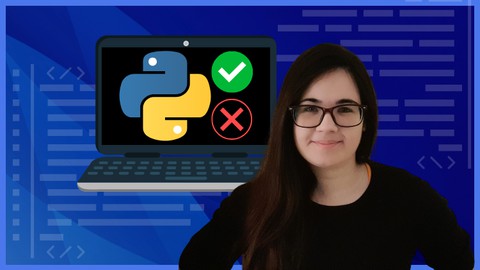
Python Best Practices: Learn to Write Clean Python Code
Python Best Practices: Learn to Write Clean Python Code, available at $69.99, has an average rating of 4.48, with 119 lectures, 47 quizzes, based on 290 reviews, and has 2300 subscribers.
You will learn about How to write Clean Python Code following the Python Style Guide (PEP 8). Best practices for naming variables, functions, classes, methods, and sequences. Best practices for indentation, line breaks, blank lines, and whitespaces in Python. How to write clean Python loops with enumerate(), zip(), break, and the else clause. Best practices to work with Object-Oriented Programming in Python. How to work with files following the Python Style Guide. Tips to write more "pythonic" code (swap variables, list comprehensions, merge dictionaries, the walrus operator, and more). How to document your code with block comments, in-line comments, and docstrings. This course is ideal for individuals who are Students learning Python who want to learn best practices and style guidelines. or Self-taught learners with basic Python knowledge who wish to write clean Python code following best practices. or Python developers who would like to dive deeper into the Python Style Guide (PEP 8). or Developers who are learning Python and would like to expand their knowledge. It is particularly useful for Students learning Python who want to learn best practices and style guidelines. or Self-taught learners with basic Python knowledge who wish to write clean Python code following best practices. or Python developers who would like to dive deeper into the Python Style Guide (PEP 8). or Developers who are learning Python and would like to expand their knowledge.
Enroll now: Python Best Practices: Learn to Write Clean Python Code
Summary
Title: Python Best Practices: Learn to Write Clean Python Code
Price: $69.99
Average Rating: 4.48
Number of Lectures: 119
Number of Quizzes: 47
Number of Published Lectures: 119
Number of Published Quizzes: 47
Number of Curriculum Items: 166
Number of Published Curriculum Objects: 166
Number of Practice Tests: 1
Number of Published Practice Tests: 1
Original Price: $39.99
Quality Status: approved
Status: Live
What You Will Learn
- How to write Clean Python Code following the Python Style Guide (PEP 8).
- Best practices for naming variables, functions, classes, methods, and sequences.
- Best practices for indentation, line breaks, blank lines, and whitespaces in Python.
- How to write clean Python loops with enumerate(), zip(), break, and the else clause.
- Best practices to work with Object-Oriented Programming in Python.
- How to work with files following the Python Style Guide.
- Tips to write more "pythonic" code (swap variables, list comprehensions, merge dictionaries, the walrus operator, and more).
- How to document your code with block comments, in-line comments, and docstrings.
Who Should Attend
- Students learning Python who want to learn best practices and style guidelines.
- Self-taught learners with basic Python knowledge who wish to write clean Python code following best practices.
- Python developers who would like to dive deeper into the Python Style Guide (PEP 8).
- Developers who are learning Python and would like to expand their knowledge.
Target Audiences
- Students learning Python who want to learn best practices and style guidelines.
- Self-taught learners with basic Python knowledge who wish to write clean Python code following best practices.
- Python developers who would like to dive deeper into the Python Style Guide (PEP 8).
- Developers who are learning Python and would like to expand their knowledge.
Learn to write Clean Python Code following the Official Python Style Guide and Python Best Practices. Expand your skills with engaging video lectures, diagrams, quizzes, articles, and additional resources.
This course is your Python Best Practices Handbook where you can find Python best practices and tips to write “pythonic” code.
Learn to Write Clean Python Code and Take your Python Skills to the Next Level
-
Write clean, readable, and maintainable Python code.
-
Assign meaningful names to your variables, functions, classes, and methods.
-
Learn how to indent Python code following the Python Style Guide.
-
Apply Python best practices for line length, line breaks, and blank lines.
-
Use whitespaces appropriately with variables, parentheses, operators, commas, colons, and semicolons.
-
Learn Python best practices to write comments in your code and why they are helpful to write readable code.
-
Apply Python best practices to work with strings, sequences, operators, functions, loops, files, and object-oriented programming.
-
Plus, learn additional tips to write “pythonic” code (the walrus operator, list comprehension, dictionary comprehension, and more…)
Course Updates
The course is frequentlyupdated with new lectures, projects, and resources:
-
September 2023 – NEW! Code editor updated to Visual Studio Code.
-
September 2023 – NEW!Updated the PDF course study guide.
-
September 2023 – NEW!Updated lectures with a new style.
-
August 2023 – NEW!New discussion topics.
-
August 2023 – NEW!Updated articles.
Python and Clean Code: In-demand Skills Around the World
Python is currently one of the most popular programming languages and its popularity continues to rise every year. It is used for real-world applications in diverse areas such as Web Development, Data Science, Machine Learning, Artificial Intelligence and many more.
If you are learning Python or if you already have some experience with this language, learning how to write clean, readable, and concise Python code following the best practices of the language is your next step into the amazing and powerful world of Python.
Learning Material & Resources
Throughout the course, you will find these resources:
-
Video Lectures:video lectures with carefully designed graphics and diagrams. You will learn the best practices of each topic with illustrative examples.
-
Quizzes: check your knowledge with 45+ quizzes with 213+ questions that provide unlimited attempts and instant feedback.
-
Articles: read articles with detailed explanations and illustrations to complement your knowledge.
-
Study Guide: review for the course exam with a detailed and unique PDF study guide with 120+ questions.
-
Course Exam: take a final course exam with 30+ questions to test your knowledge. The exam has unlimited attempts and detailed results for each attempt.
What makes this course unique?
This course is unique because of its emphasis on providing visual and detailed explanations of the best practices of Python. You will not only learn how to use these principles in Python, you will understand the purpose of each guideline and visualize it.
Unique study materials complement the course experience. You will find a PDF study guidespecifically designed for the course with 120+ questions on the course content.
You will check your knowledge with Quizzes that will make you think more deeply about the topics presented in each section and you will receive instant feedback to check your answers.
You will receive a Certificate of Completion that you can add to your CV and social media profiles to showcase your new skills.
You will also have Lifetime Access to the course.
You are very welcome to watch the preview lectures and check out the full course curriculum.
If you are looking for an engaging, visual, and practical course, then you’ve found it.
Enroll now, add “Python Best Practices” and “Clean Code” to your resume, and showcase your new skills.
Course Curriculum
Chapter 1: Welcome to the Course: Python Best Practices
Lecture 1: Importance of Writing Clean Code
Lecture 2: Welcome to the Course – Important Course Information
Lecture 3: Introduce Yourself and Share your Goals
Lecture 4: When to Follow PEP 8 Guidelines (and When Not To)
Chapter 2: Variables Best Practices in Python
Lecture 1: Welcome to this Section
Lecture 2: Naming Conventions in Programming
Lecture 3: Variable Naming Rules and Conventions in Python
Lecture 4: Variable Naming Best Practices
Lecture 5: Variable Names That You Should Avoid in Python
Lecture 6: How to Solve Naming Conflicts with Python Keywords
Lecture 7: Constants in Python
Lecture 8: Boolean Variables: Naming Conventions
Lecture 9: Discussion Topic: Share your Thoughts
Chapter 3: Indentation Best Practices in Python
Lecture 1: Welcome to this Section
Lecture 2: Importance of Indentation in Python
Lecture 3: Indentation Guidelines (Tabs vs. Spaces)
Lecture 4: Important Concept: Hanging Indentation
Lecture 5: How to Indent and Unindent Code in Visual Studio Code
Lecture 6: Tabs to Spaces and Spaces to Tabs
Lecture 7: Change Spaces per Level of Indentation in Visual Studio Code
Lecture 8: Indentation Best Practices for Multi-line Conditions
Lecture 9: Discussion Topic: Share your Thoughts
Chapter 4: Lines Best Practices: Break, Length, and Blank Lines
Lecture 1: Welcome to this Section
Lecture 2: Line Length Limit
Lecture 3: Implied Line Continuation in Python
Lecture 4: Line Breaks with Backslashes
Lecture 5: Binary Operators and Line Breaks
Lecture 6: Avoid Writing Compound Statements in a Single Line
Lecture 7: Blank Lines in Functions, Methods, and Classes
Lecture 8: Discussion Topic: Share your Thoughts
Chapter 5: Whitespaces Best Practices in Expressions and Statements
Lecture 1: Welcome to this Section
Lecture 2: Whitespace and Variables
Lecture 3: Whitespace and Parentheses, Brackets, and Braces
Lecture 4: Whitespace and Commas, Colons, and Semicolons
Lecture 5: Whitespace and Operators
Lecture 6: Trailing Whitespaces Best Practices
Lecture 7: Discussion Topic: Share your Thoughts
Chapter 6: Comments and Docstrings Best Practices
Lecture 1: Welcome to this Section
Lecture 2: Importance of Comments to Write Clean Code
Lecture 3: Bad Practice: Over-Commenting Your Code
Lecture 4: Inline Comments
Lecture 5: Block Comments
Lecture 6: Introduction to Docstrings
Lecture 7: One-Line Docstrings
Lecture 8: Multi-Line Docstrings
Lecture 9: Print and Read Docstrings with __doc__
Lecture 10: Discussion Topic: Share your Thoughts
Chapter 7: Strings Best Practices in Python
Lecture 1: Welcome to this Section
Lecture 2: Single-Quoted vs. Double-Quoted Strings
Lecture 3: Triple-Quoted Strings Best Practices
Lecture 4: Spaces in String Slicing
Lecture 5: String Methods vs. The string Module
Lecture 6: How to Concatenate Strings to Optimize Performance
Lecture 7: How to Check Prefixes and Suffixes
Lecture 8: Whitespace in Python Strings (+ How to Trim Whitespace)
Lecture 9: Discussion Topic: Share your Thoughts
Chapter 8: Operators Best Practices in Python
Lecture 1: Welcome to this Section
Lecture 2: Quick Tip: How to Leave or Update Your Review
Lecture 3: Parentheses in Expressions and Statements
Lecture 4: Comparison Operators Chaining
Lecture 5: The is Operator: Comparison to None
Lecture 6: is not … vs. not … is
Lecture 7: Truthy and Falsy Values
Lecture 8: Example of Truthy and Falsy Values
Lecture 9: Quick Review: Operators, Spaces, and Line Breaks
Lecture 10: Discussion Topic: Share your Thoughts
Chapter 9: Sequences Best Practices (Lists, Tuples, and Dictionaries)
Lecture 1: Welcome to this Section
Instructors
-
Estefania Cassingena Navone
Software Developer, Instructor and Technical Writer
Rating Distribution
- 1 stars: 1 votes
- 2 stars: 1 votes
- 3 stars: 23 votes
- 4 stars: 98 votes
- 5 stars: 167 votes
Frequently Asked Questions
How long do I have access to the course materials?
You can view and review the lecture materials indefinitely, like an on-demand channel.
Can I take my courses with me wherever I go?
Definitely! If you have an internet connection, courses on Udemy are available on any device at any time. If you don’t have an internet connection, some instructors also let their students download course lectures. That’s up to the instructor though, so make sure you get on their good side!
You may also like
- Best Cybersecurity Fundamentals Courses to Learn in March 2025
- Best Smart Home Technology Courses to Learn in March 2025
- Best Holistic Health Courses to Learn in March 2025
- Best Nutrition And Diet Planning Courses to Learn in March 2025
- Best Yoga Instruction Courses to Learn in March 2025
- Best Stress Management Courses to Learn in March 2025
- Best Mindfulness Meditation Courses to Learn in March 2025
- Best Life Coaching Courses to Learn in March 2025
- Best Career Development Courses to Learn in March 2025
- Best Relationship Building Courses to Learn in March 2025
- Best Parenting Skills Courses to Learn in March 2025
- Best Home Improvement Courses to Learn in March 2025
- Best Gardening Courses to Learn in March 2025
- Best Sewing And Knitting Courses to Learn in March 2025
- Best Interior Design Courses to Learn in March 2025
- Best Writing Courses Courses to Learn in March 2025
- Best Storytelling Courses to Learn in March 2025
- Best Creativity Workshops Courses to Learn in March 2025
- Best Resilience Training Courses to Learn in March 2025
- Best Emotional Intelligence Courses to Learn in March 2025






















